Discovering the Dust Bowl in 2019,
researching my next graphic novel
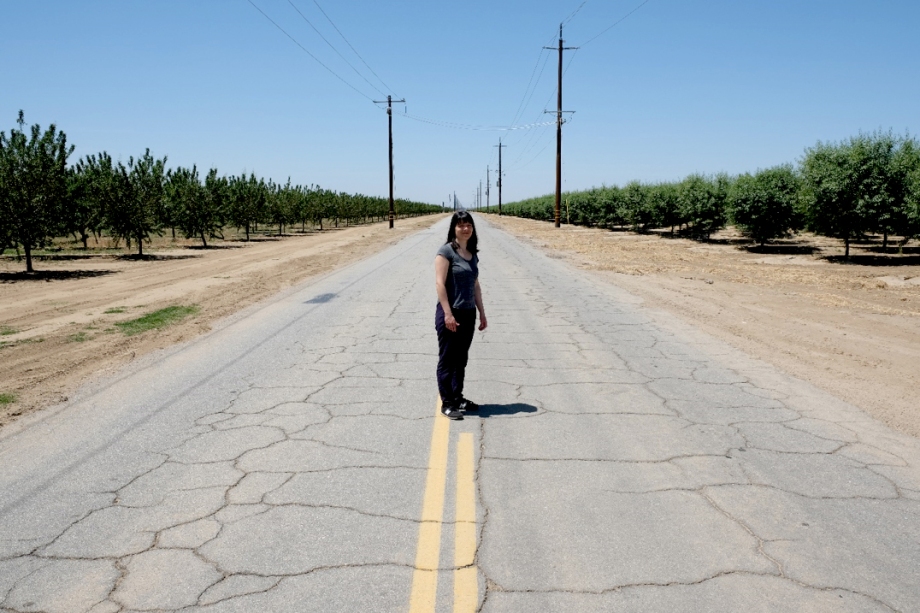
In April and May of 2019, I made a very special trip through the United States. I was doing research for my upcoming graphic novel Days Of Sand (Jours de Sable) which takes place in Oklahoma and California in the 1930s. My partner Bob joined me, as we interviewed experts and visited museums along the way. But mostly, we enjoyed seeing the real locations where the characters of the book would have lived. In this blog, a selection of photos will accompany a retrospect of our ten days on the road. The trip was funded by the travel grant given by the Dutch Literature Fund (www.letterenfonds.nl) and the book will be published by Dargaud and Scratch Books in 2021.
Book details (updated April 2021):
French release: Jours de Sable (FR), May 2021
Dutch release: Dagen van Zand (NL), May 2021
English release: to be announced
The synopsis
United States, 1937. John, a young photographer from New York, is hired to document the lives of poor Oklahoma farmers living through terrible dust storms, in a region called the Dust Bowl. As the heavy storms grow bigger, John finds himself in a tragedy bigger than he could have ever imagined.
 Concept art from the graphic novel
Concept art from the graphic novel
The historic events that inspired the story of “Days of Sand”
The Dust Bowl and migration of the Okies
In 1929, the American stock market crashed, and the Great Depression hit the United States. While everybody’s eyes were focused on Wall Street, other areas of the country had to deal with something way more frightening. Oklahoma, Kansas and Texas were the center of the so-called Dust Bowl: a series of dust storms that tormented the land and its farmers. In a couple of years, these storms would turn the American Great Plains into an American Sahara. The reason for this ecological disaster was mostly man-made: By transforming the grassland area into farmland, the entire eco-system changed. After a period of severe drought, dust started to rise up from the soil, forming huge clouds in the air: Black Blizzards. Thick layers of dust settled in the wooden homes. Schools distributed oxygen masks for the children to breathe. Dust clouds would black out the sun completely, and witnesses described it as ‘midnight without the stars’. Many people in the affected areas died of famine and dust pneumonia.


Dust clouds and black blizzards hitting the Dust Bowl area
 Cars “drowned” in sand
Cars “drowned” in sand
Meanwhile, in the west, Californian farmers were looking for new cheap labor after the Mexican Repatriation. When the Dust Bowl-stricken farmers heard of this labor void, many took their belongings and drove to California in search of jobs. But the Californians were not prepared for the hundreds of thousands of people that would come their way. There simply wasn’t enough work for everyone. The Dust Bowl refugees had no homes and camped in makeshift squatter camps, or in their car. Often they would have to sell their belongings just to be able to feed their children. They were discriminated heavily, and the Californians called them Okies, meaning ‘scum’. Many farmers wished they had never left.

A family on the road to California, looking for work
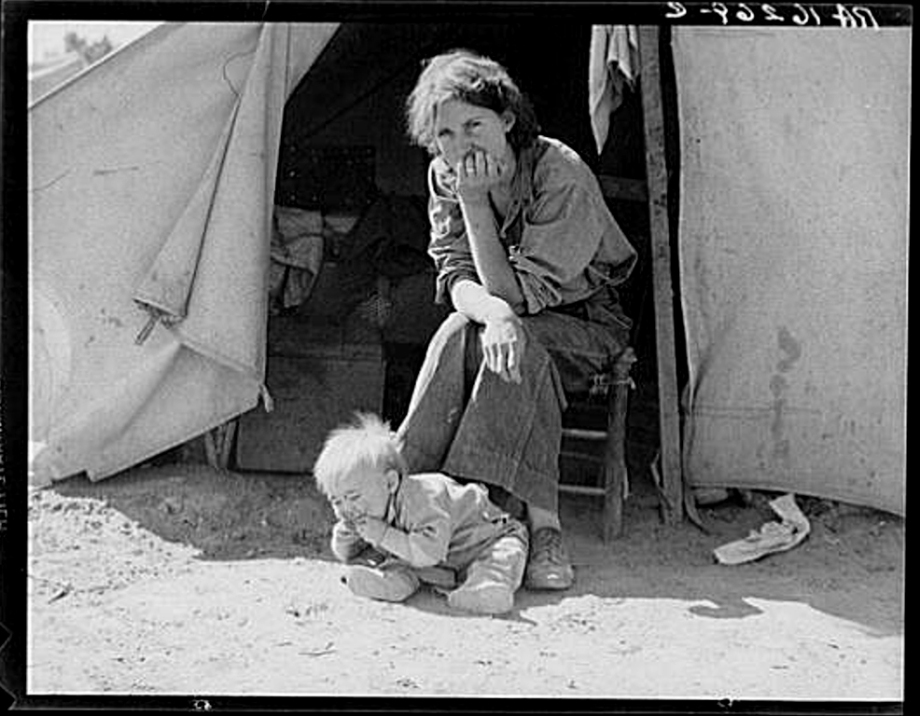 Eighteen-year-old mother from Oklahoma, now a California migrant, March 1937
Eighteen-year-old mother from Oklahoma, now a California migrant, March 1937
The government finally took control when so-called government camps were built in California. Here, the farmer families from the Dust Bowl could live in tents, and they could use running water and bathrooms. Still, most of the Dust Bowl refugees could not get into the government camps at all. There was only limited space, while the number of incoming people continued to grow.

A government camp in California
Ironically, the only solution to this situation was triggered by World War II. Many boys were sent out to Europe to fight, others were offered jobs in factories to produce machinery for the war overseas. The farmers ended up as factory workers. Not many returned to Oklahoma. The Dust Bowl itself ended as rains returned to the area, and farmers decided to change their ways of farming. More grasslands were kept, and new irrigation methods were invented.
John Steinbeck and Dorothea Lange
John Steinbeck’s novel The Grapes of Wrath (1939) became the most well-known depiction of the Dust Bowl refugees. The heartbreaking story of the Joad family facing the hardships on the road to California touched every person who read it. The book was a huge success and became even more famous when a movie starring Henry Fonda was made in 1940. The book and the film changed the country’s viewpoint on the refugees from Oklahoma completely, and it was one of the major works for which Steinbeck received the Nobel Prize in 1962. But not only Steinbeck has shaped our view of the Dust Bowl refugees.

Photographer Dorothea Lange played a huge role in the way we think of the period visually. Her many black-and-white photographs were commissioned by the Resettlement Administration (which later became the Farm Security Administration, the FSA.) This agency was created to help farmers, by resettling them to modern homes and better farmland. The agency hired photographers to document the farmers and their living conditions. Most famous is the photograph Migrant Mother, a portrait made in 1936 by Dorothea Lange. In the photo, Florence Owens Thompson, a migrant woman living on the road, holds her three children while staring in the distance. There is no father in sight. The consequences of poverty are clearly visible: Florence was only 32 years old when the picture was taken, but because of her frown and wrinkles, she looks like an older woman. The photo became the icon of poverty worldwide, and it is considered one of the greatest photographs ever made.

Migrant Mother, 1936, by Dorothea Lange
Why a roadtrip?
Although the graphic novel Days of Sand will be fiction, it is based on the true events that took place during the Dust Bowl in Oklahoma. The visual references found online were not sufficient to create a complete image of that time. Because I’m making drawings, I needed more visual input. I also wanted to talk to the people who have experienced the Dust bowl or are related to it; and I wanted to talk to people who had researched the period before me. We also wanted to experience the trip that the Okies made westwards, to California, and see what they saw. That trip would give us the ultimate insight in what it was like to be a Dust Bowl refugee in the 1930s.
Global itinerary
- Part 1: April 27 Oklahoma City History Center, Oklahoma
- Part 2: April 28, 29, 30 Cimarron County, Oklahoma
- Part 3: May 1 till May 4 Roadtrip to Bakersfield, California
- Part 4: May 5 Sunset Migrant Camp, Bakersfield, California
- Part 5: May 6 John Steinbeck Centre, Salinas, California
- Part 6: May 8 Dorothea Lange Collection in the Oakland Museum of California
 Blowing Dust Area, a sign we saw on the road to California. I just had to take a picture!
Blowing Dust Area, a sign we saw on the road to California. I just had to take a picture!
Part 1: April 27:
Oklahoma City History Center
In the weeks before our departure, I had contacted several experts on the subject to ask them if I could interview them while visiting the US. One of the most enthusiastic responses came from historian Jeffrey Briley, who works at the Oklahoma History Center. Jeffrey was a photographer himself, which was very useful. When we visited the Center on our first day, he had dug up a whole collection of old cameras from the archives. With our plastic gloves on, we were allowed to handle the cameras carefully and look at them from up close. We talked about what cameras the photographers would use in the field, and how they worked. We talked about negatives, film, cassettes and more. The whole interview was recorded. The rest of the day was spent in the research library of the History Center, looking up photos, newspaper articles and interviews about the Dust Bowl. It was a very succesful day, and we enjoyed our visit a lot.
 Jeffrey Briley and me in the Oklahoma History Center archives, with the many cameras!
Jeffrey Briley and me in the Oklahoma History Center archives, with the many cameras!

A chance to see many cameras from the thirties up close – very close.

So many different models of cameras, and all of them had different stories.

Here I’m searching the computers of the Oklahoma History Center for reference material. Lots of photos and newspaper articles were found, as well as some books that we bought at the bookshop within the Center. A day well spent! And that was only the first day.
Part 2: April 28, 29, 30:
Cimarron County
Later that day, we drove from Oklahoma City to the so-called pan handle (which is named after the shape of the region, see map below). This is where most dust storms would hit.

The history of this part of Oklahoma is unique and very interesting. In the 1930s, the panhandle (or ‘No Man’s Land‘) endured disaster upon disaster, when plagues and drought entered the region. Around 1934, it became the center of the Dust Bowl. As a result, most farmers left the Cimarron County region. Today, we can still see lots of abandoned houses and sheds and barns. Windmills are peeping and cracking, while no water is pumped anymore. These scenes are perfect material for reference and on our way to Boise City, the main city in the panhandle, we had to stop multiple times to take photographs.

A typical Dust Bowl scene we saw; a shed and a rusty old windmill…
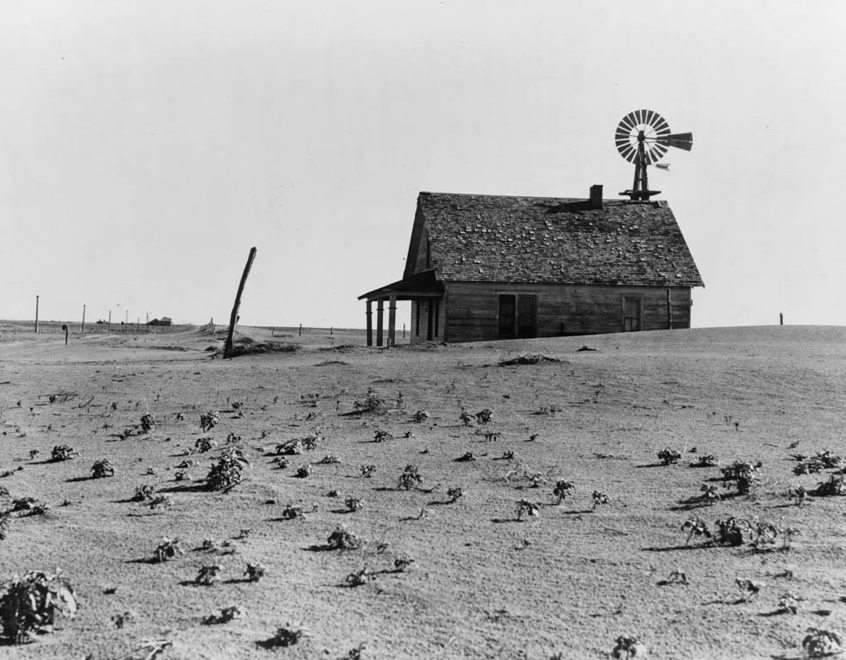
…Not so different from this Dust Bowl photograph from Dalhart Texas, 1938.

Close-up of the rusty windmill. It was one of the many we’d see along the way.
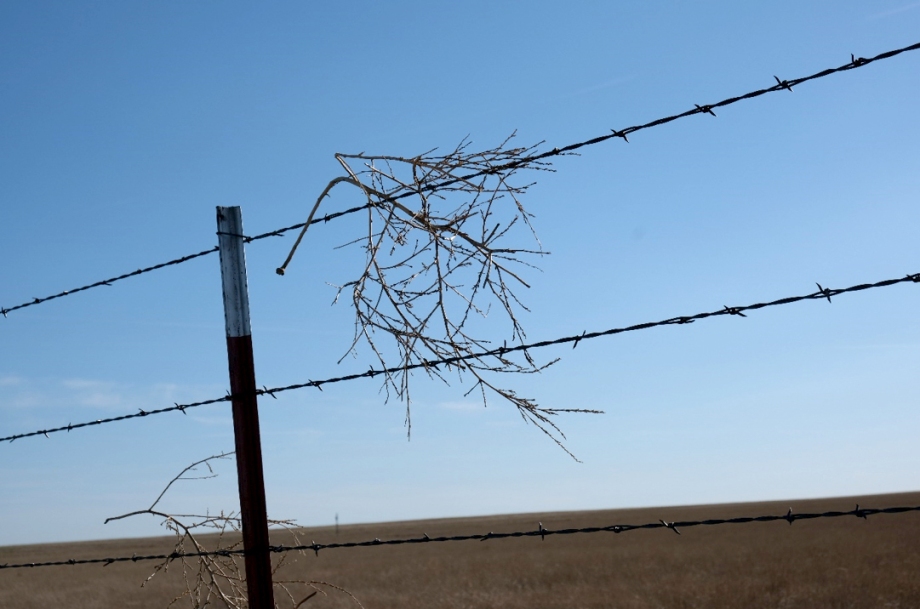
This made my heart skip a beat: Real tumbleweed! In a book about the Dust Bowl, one of the witnesses said that the tumbleweed would get trapped in the fences back then, and the dust would pile up against it. This is why lots of the cattle walked over the fences and got lost. It was so great to see the tumbleweed get tangled up in the fences in real life, just like the book pointed out.
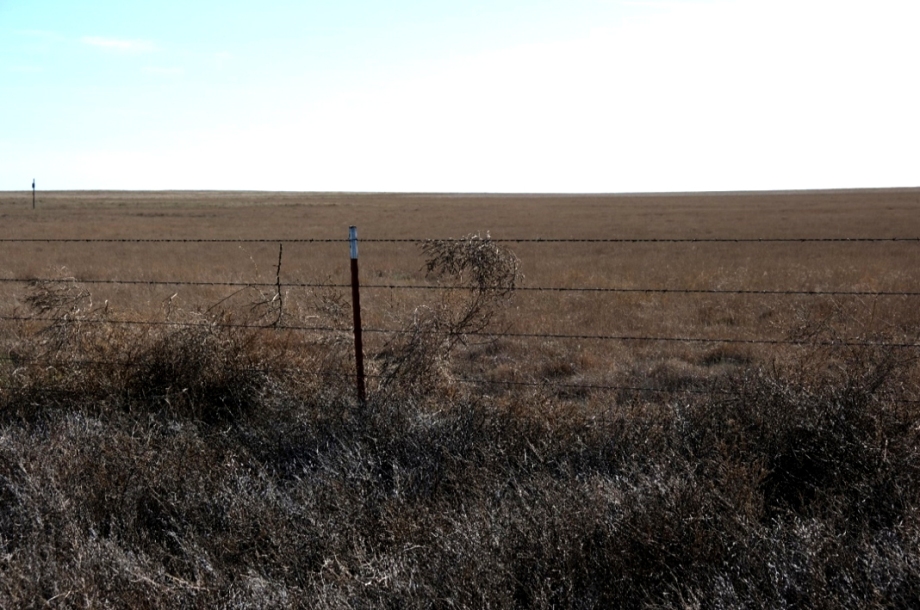
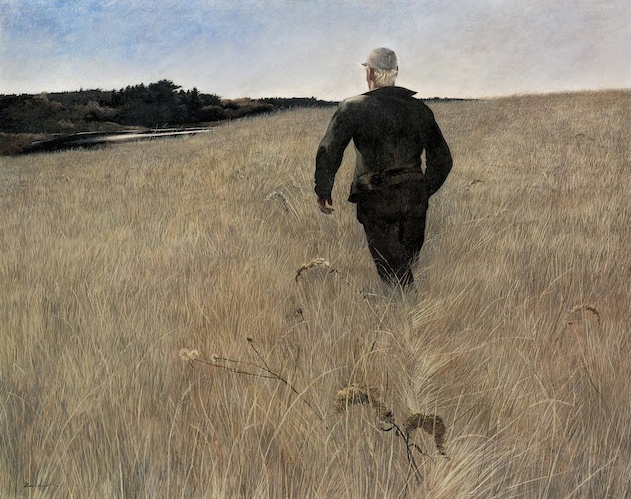
More tumbleweed tangled up in the fences, and the orange-brown plains of dry grass, which reminded me of the paintings of Andrew Wyeth (second picture) everytime.
 An old shed, abandoned, but it perfectly captures the atmosphere that many of the old Dust Bowl photos have.
An old shed, abandoned, but it perfectly captures the atmosphere that many of the old Dust Bowl photos have.
 The old shed again, with dried out soil. Not as sandy as it would have looked in the thirties, but still it’s clear that the absence of rain is having its effect on the land.
The old shed again, with dried out soil. Not as sandy as it would have looked in the thirties, but still it’s clear that the absence of rain is having its effect on the land.
 Another abandoned Dust Bowl house. The houses would often stand next to a tree or a couple of trees. For shade? Or were they planted there by the inhabitants?
Another abandoned Dust Bowl house. The houses would often stand next to a tree or a couple of trees. For shade? Or were they planted there by the inhabitants?
 View of the road towards the panhandle, or ‘No Man’s Land’ as it used to be called. No wonder…
View of the road towards the panhandle, or ‘No Man’s Land’ as it used to be called. No wonder…
 Cattle in the field, not escaping this time!
Cattle in the field, not escaping this time!
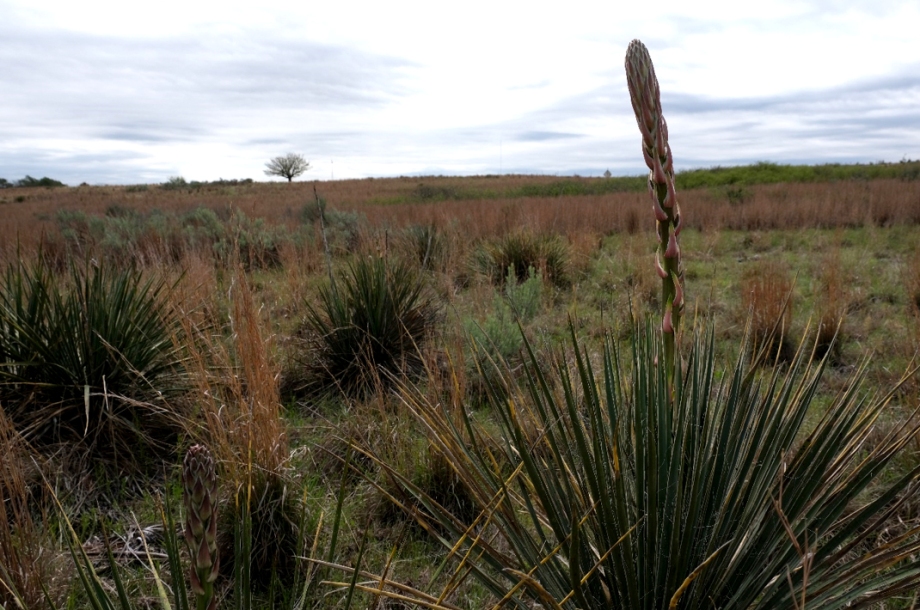

Flora & Fauna of the Great Plains. Very useful to know what kind of grass and plants are growing in the fields. I can’t just make something up…
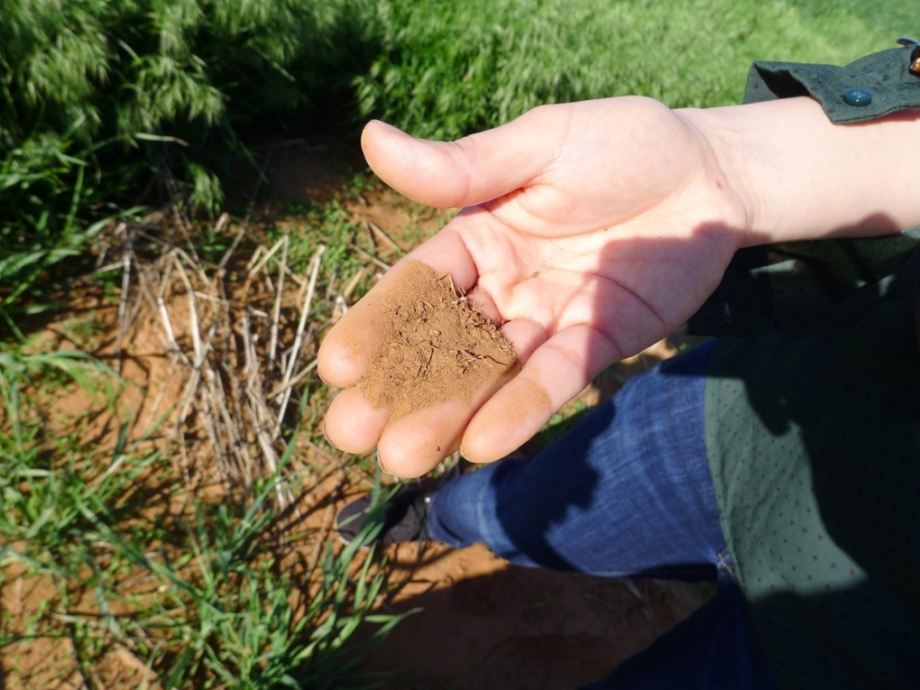 Here I’m taking a look at the colour of the soil. Yes, thorough research! It is important, because the colour of the dust clouds would change with the direction the sand was blowing from. If it came from the south, (for example) it would have been more red, from the north it was brown. By the colour of the clouds, the farmers could say about the storm: “There’s a visitor from Kansas today” or “We have a visitor from Oklahoma”.
Here I’m taking a look at the colour of the soil. Yes, thorough research! It is important, because the colour of the dust clouds would change with the direction the sand was blowing from. If it came from the south, (for example) it would have been more red, from the north it was brown. By the colour of the clouds, the farmers could say about the storm: “There’s a visitor from Kansas today” or “We have a visitor from Oklahoma”.
Oklahoma wildlife!
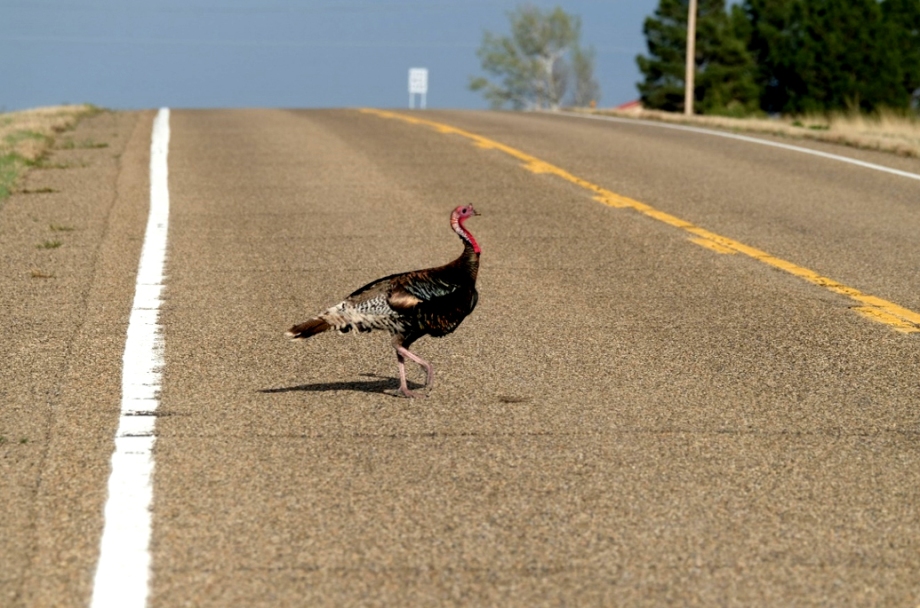
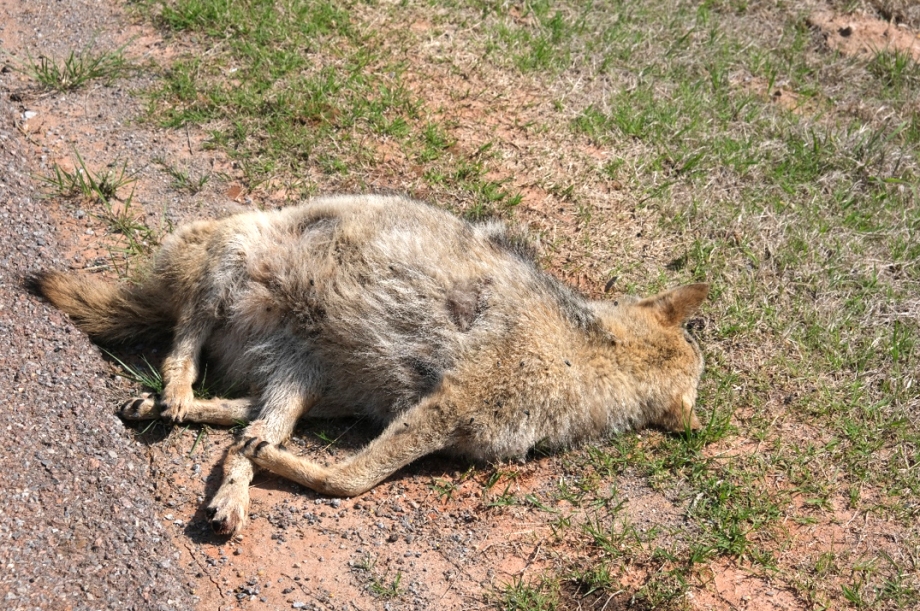

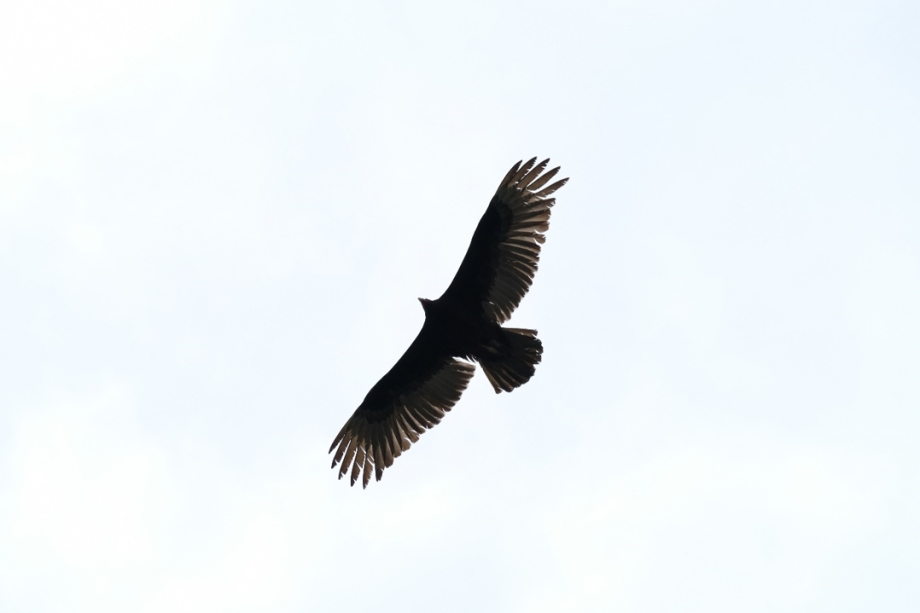

Oklahoma wildlife: a wild turkey, a dead coyote, pronghorns, a vulture, and jackrabbits. All of these animals were present during the Dust Bowl, though some may have left temporarily as a result of the storms. Seeing these animals up close (or from far away) was incredible. I will definitely draw all of them in the book.

The jackrabbits became a huge plague in the 1930s, because their natural predators had left the area (see photo above). I was thrilled to see real jackrabbits on this trip, as they are going to play an important part in the story (spoilers)!
 We had a typical Oklahoma snack, which was also eaten during the thirties: Biscuits. They look like scones, but the texture is slightly different. The biscuits were featured in the Grapes of Wrath, as the Joads main meal on the road (served mostly with gravy). Although we weren’t expecting the biscuits to still be around at all, they turned up at every breakfast buffet in Oklahoma. They tasted delicious. And of course I had to take a photo for reference!
We had a typical Oklahoma snack, which was also eaten during the thirties: Biscuits. They look like scones, but the texture is slightly different. The biscuits were featured in the Grapes of Wrath, as the Joads main meal on the road (served mostly with gravy). Although we weren’t expecting the biscuits to still be around at all, they turned up at every breakfast buffet in Oklahoma. They tasted delicious. And of course I had to take a photo for reference!

Trying to fit in the American farmer’s lifestyle!
The Cimarron Heritage Center
On Monday, we arrived at the Cimarron Heritage Center in Boise City, Oklahoma. This was one of the highligths of the trip. It’s partly indoors, partly outdoors, has many buildings on its site and it has an astonishing collection of artifacts from the Dust Bowl.
The most interesting building for me was the restored Dust Bowl House. This was an old school that became a family’s home during the Dust Bowl. The house was renovated, but only slightly, and most of the objects in the house were original. Even the dust on the table was original Dust Bowl dust!

One of the things I hadn’t realized up till visiting this house, was how much trouble I will have in making a book in full-colour, while the only photographed and filmed reference that is left, is black-and-white. How would I ever find out if a blanket was bright red or grey? How would I know if their table cloths were white, perhaps or more violet?
By visiting this house, a lot of my questions were answered.

This bedroom wall in the house was covered with old yellow newspapers, which was something I had seen already on many photographs from that time (see below). The reason the people put these newspapers up on the wall, was that the dust was so tiny that it would simply come through the wooden boards of the house. With the newspapers, much more dust was kept out.

Newspapers on the wall in an old Dust Bowl home. Also notice the homemade little rug on the floor, similar to the one in the museum’s home. Now I have an idea what the actual colours of that rug would look like!
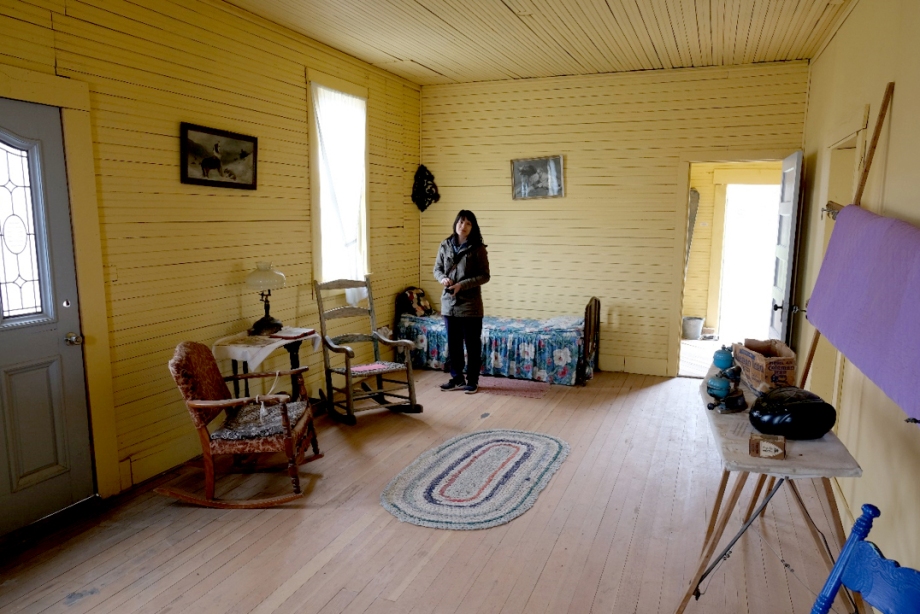
Do you notice the colour on the walls? It’s yellow. Till then, I had figured the walls would probably have been brown (wood) or white. With this in mind, I met the museum’s curator Jody Risley, and asked her what colours were used for interiors. She told us right away that in the thirties there were only two colours of paint that were used on interior walls: bright yellow and turquoise. It was such an interesting fact! And so useful, since I need to draw many 30’s houses in my book.

Photo of an interior taken during the Dust Bowl years. Below a picture of the Dust Bowl house in Boise City.

And another important detail: The cups and plates were all turned upside down. This was done to prevent the dust from settling on the plates before eating a meal or drinking.
 Cans from the thirties. It may seem like a detail, but it is very useful for my research.
Cans from the thirties. It may seem like a detail, but it is very useful for my research.

As the families didn’t have much money to spend, pillow cases and curtains were all made of the same fabric: Grain and seed sacks. The children’s clothing was made of these sacks as well; mothers made dresses for their girls and shirts for their boys.

Here it’s clear that somebody had laid his head down for a while, because of the visible “dust crown” on the pillow. Each morning, when the people woke up, dust would have settled everywhere except where they slept. So on each pillow, a crown of dust had formed around the person’s head. A beautiful visual detail that I will definitely use in the book.
 Objects in the cupboards that reflect the time they lived in.
Objects in the cupboards that reflect the time they lived in.

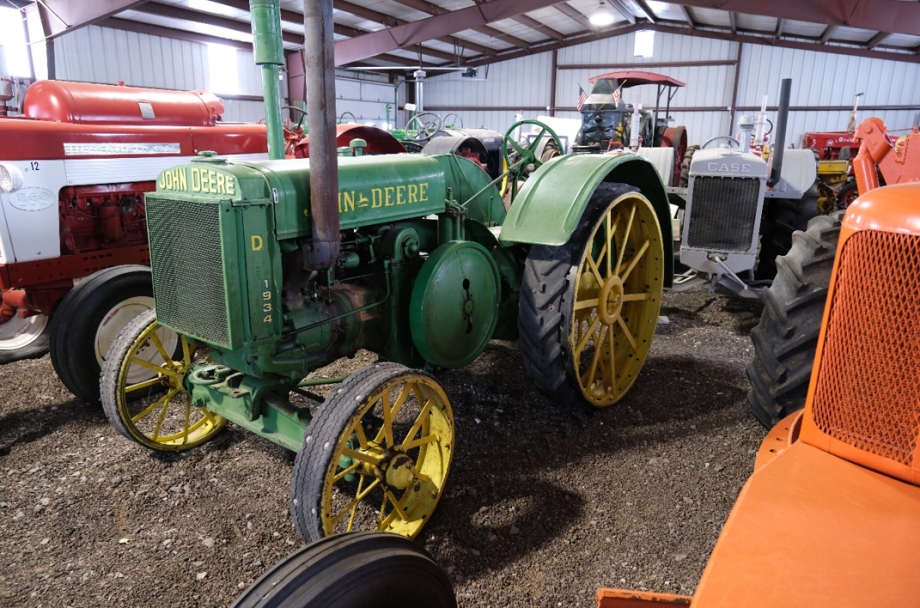
In another building at the Cimarron Heritage Center site, there was a huge collection of old tractors and farm equipment. Another gold mine for me, as the story would feature farmers working on the land. I looked up the tractors from the 1930s and took pictures. The commonly used tractors in that area were John Deere’s.

The next building had a huge collection of old cars, which was again very useful. I asked Jody Risley which cars would have been used to travel to California and she pointed out two models (as seen on the pictures). The most popular cars at that time were Buick and Ford. For example, a Ford Model A Sedan. It had to be a car that could carry big families and lots of luggage. Often the families would build an extra floor on top of the car to be able to take more belongings with them.
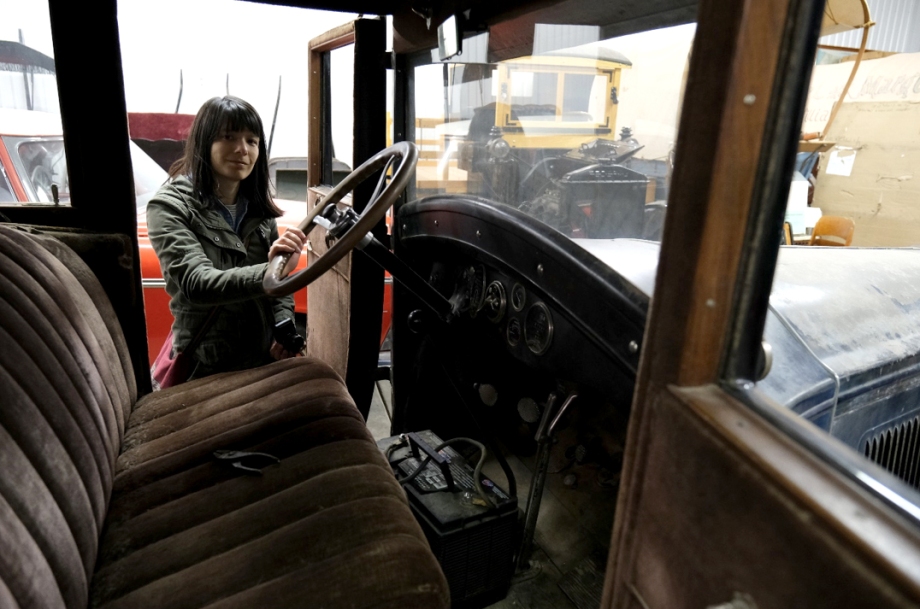 Checking out the interior!
Checking out the interior!

Outside, we briefly visited the other buildings, like the old toilet house that belonged to the Dust Bowl house.
Then unexpectedly, there was another highlight of the trip, though it may not seem like much. In the exhibition building, there was a box of original Dust Bowl dust, found in the attic of a farmer’s house. It was incredible to see it, feel it. The dust was much tinier than grains of sand. It was soft, greyish and quite cold. It seems surreal that this dust can have such an impact on people’s lives, and even kill children.
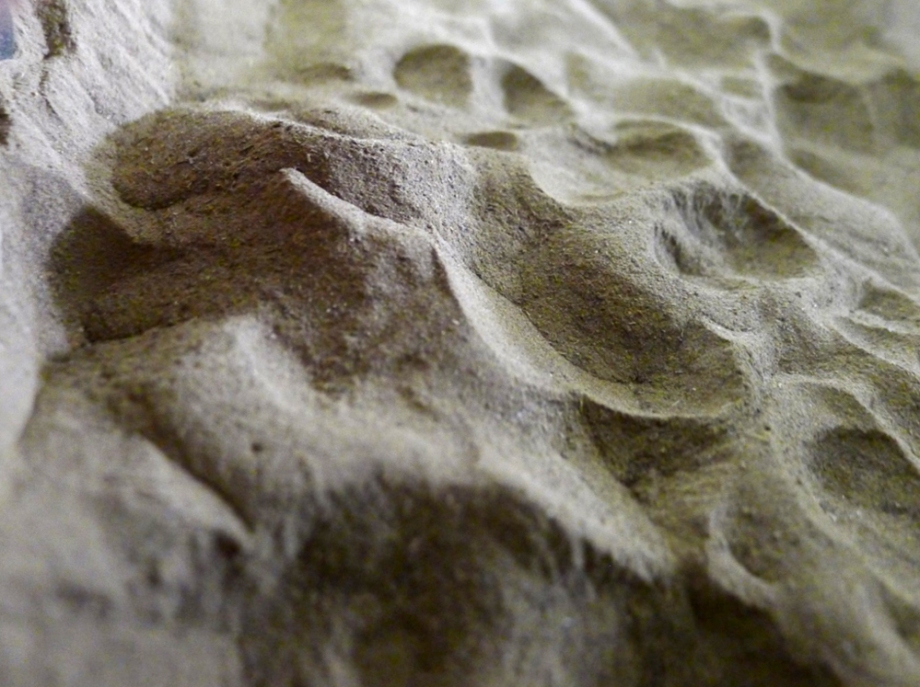
The dust bowl dust up close.
Part 3: May 1st till May 4th :
Roadtrip to Bakersfield

After this incredible visit, we drove further on to the west. This time we were headed to California, down Route 66, the “Mother Road” that all the migrants from Oklahoma took. Of course, these days the highway doesn’t follow the exact same route completely, but we definitely got a good look at the landscape and how it changed. The trip took about 4 days and it was breathtaking.

The further west, the more the plains turned into canyons and red rocky mountains.

An old stranded car; All brown because of the rust, it forms a beautiful visual proof of a time where thousands of people hit the road in search of a better life.

An elk grazing by the road, near the Grand Canyon.

Desert cactus, in the Mojave Desert Preserve.
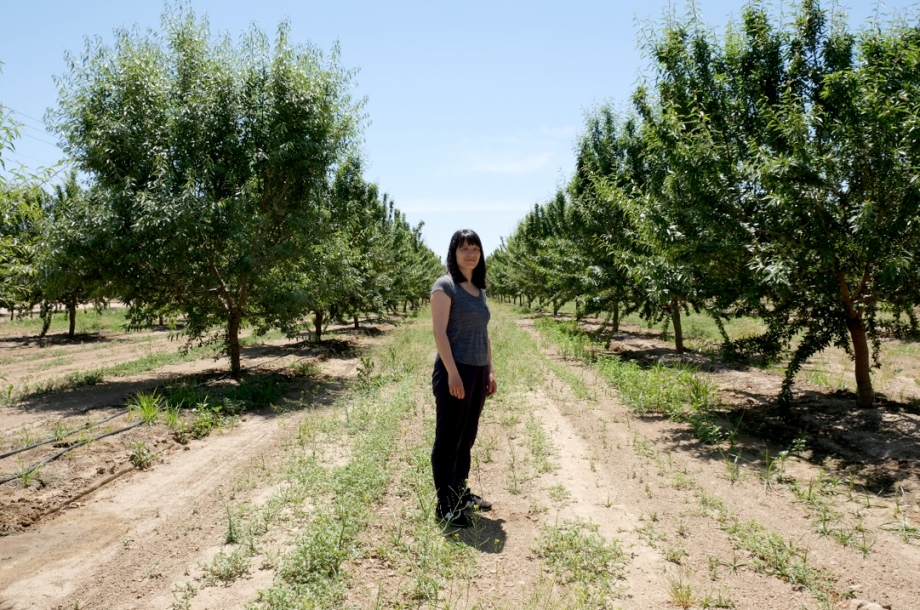
And finally, after 4 days, we arrived in Bakersfield. We were looking for the famous hill that the Joad family from the Grapes of Wrath drove down, when they saw the blooming orchards. But unfortunately, that hill never came. We did find the orchards as we drove further through the city. It was May, and the first migrant workers started working on the field, mostly Mexicans, as some residents explained to us later. They were doing the work that the Oklahoma migrants would have done 90 years earlier.
 Professor Dodd and his wife (left, and right), with me and professor Garcia in the middle.
Professor Dodd and his wife (left, and right), with me and professor Garcia in the middle.
One of the people I interviewed in Bakersfield was history professor Dr. Douglas Dodd, seen left on the photo here, who specializes in environmental history. Doug kindly invited us to his home on the evening prior to the interview. He had organized a special kind of barbecue for his university colleagues that night: deep-pit. This was brought in with the Okies, and it consists of a hole in the ground where the meat is cooked in. Unfortunately, there was no hole in the ground this time! But it was delicious either way, and we had an amazing evening. All the people at the party helped us with what they knew about the Oklahoma migrants. The interview with Douglas went very well. He was able to give a better perspective on the arrival of the Okies in Bakersfield, and the consequences of their migration.
Part 4: May 5th :
Sunset Migrant Camp
We stayed in Bakersfield a little longer, because here we would visit The Sunset Migrant Camp. This was a government camp for the Oklahoma refugees coming from the Dust Bowl. The camp had running water, a camp school, tents, and even a swimming pool, which the children dug themselves. The camp was featured in the Grapes of Wrath (as the Weedpatch Camp). These days, the camp is renovated and still in use for todays migrant workers. Two women are still maintaining the original buildings: Sharon Garrison and her daughter. Sharon was born in the camp. It was very special to talk to the Garrisons and to hear their experiences first-hand, surrounded by this place, full of history.

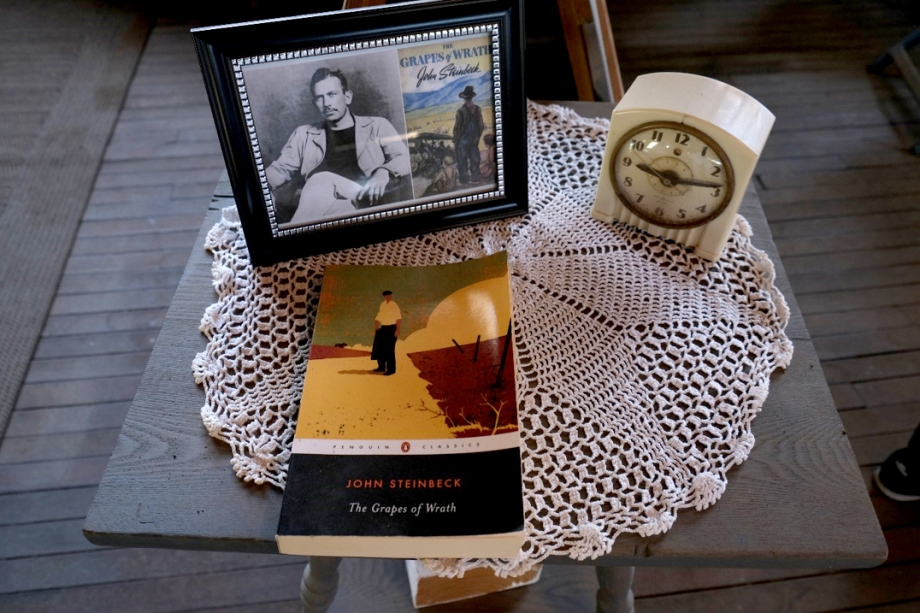
Steinbeck had visited the migrant camp often, and of course his books were there!

Interviewing Sharon in the public space of the camp.

Memorabilia from the old Sunset Migrant Camp days.

The stop-sign that stood originally by the entrance of the camp, and that was featured in the movie of The Grapes of Wrath.

Waiting as an old original building is opened up, where families stayed.

Looking at the original beds and furniture of the cabin. It was very hot, and we were told a family would usually not stay inside during the day because the heat would be unbearable.


Photo of the two oldest camp buildings. The upper one is made in May 2019, the other one in the 1930s by Dorothea Lange. As you can see, although the bright green houses have been moved to a different location, they have hardly changed at all; only the Coca Cola sign has been removed.

Sketching in the shade of the Sunset Migrant Camp.

Plaque: “From the people of Oklahoma – the Okies – who found a home here and helped build California”

One last picture before we left Bakersfield, on the road between the green orchards. This is where so many migrants wanted to go, and it felt special to have reached that destination and see the “promised land” with our own eyes. Next stop: The John Steinbeck Centre in Salinas, California!
Part 5: May 6th :
John Steinbeck Centre
The most famous depiction of the Okie history is the novel The Grapes of Wrath. It was a call to action: Steinbeck wanted the government to make the migrant’s lives better. Besides that incredible novel, Steinbeck wrote many essays about the people as well. He was close friends with Tom Collins, the manager of the Sunset Migrant Camp, and he visited the place often. I was curious how much of Steinbeck’s work was truthful, and how much was fiction. In this search, archivist Lisa Josephs helped us out with all the information we needed. She had gathered newspaper articles, magazines, interviews, letters and oral history about the period. It was a fascinating day, with once again a lot of information to process.

Lisa shows me where Steinbeck lived on an old map of Salinas, from 1934, completely handdrawn!
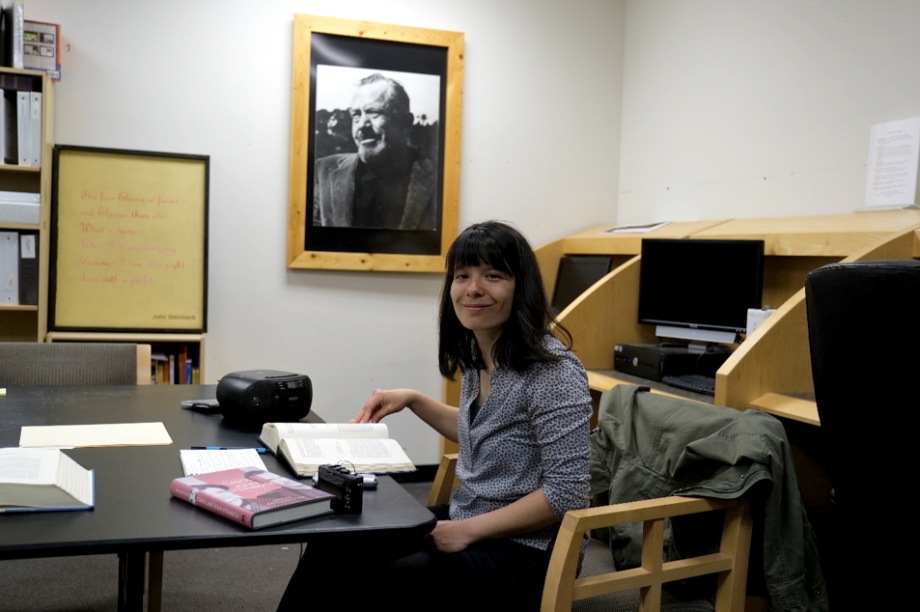
Reading the letters from Steinbeck and going through the many things Lisa had given us. On the CD player, we listened to an interview with people talking about Steinbeck.

The most interesting was this transcripted interview of a nurse who worked in the Sunset Migrant Camp. She gave incredibly detailed descriptions about the people living there. She talked about their religious practices, the diseases they often had, at what age they would usually get pregnant (young! 16!)… The details were amazing and they will help me a lot in creating a truthful image of the people of that time.
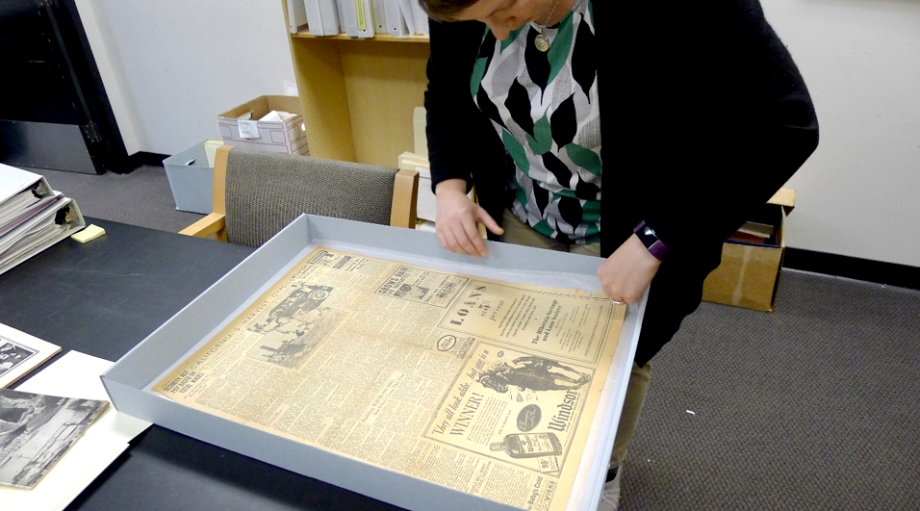
 A very special newspaper: An original copy where Steinbeck’s essay “California’s Harvest Gypsies” was published in. He got a lot of space, and there was a huge photo too – and this was even before The Grapes of Wrath came out.
A very special newspaper: An original copy where Steinbeck’s essay “California’s Harvest Gypsies” was published in. He got a lot of space, and there was a huge photo too – and this was even before The Grapes of Wrath came out.

In the exhibition space of the Steinbeck Centre, more information and objects about the subject could be found. There was even another car! We didn’t stay long, as we were about to leave for the last chapter of our trip. We left Salinas, but we couldn’t resist visiting Monterey as well. Steinbeck’s book Cannery Row is about that city, and it felt only right to visit, even shortly.
Part 6: May 8th :
Dorothea Lange Collection in the Oakland Museum of California
It seemed like we saved the best for last: The Dorothea Lange Collection in the Oakland Museum of California. I had scheduled an interview with Drew Johnson who worked at the museum, but who is also co-author of books on Dorothea Lange’s life and work. If there was anyone in the Oakland area that I had to interview about Lange’s work, it was Drew.

Before we visited the actual archives, Drew and I sat down for an interview about Dorothea’s work – and many questions were answered. Drew mentioned how Dorothea would often stay in motor courts, which were a kind of motels, when she was travelling and making her photographs. This was one of the things I wanted to find out during the trip! I also asked him many other questions, for example, why she would always shoot black and white (while colour photography was already available) and how much freedom she had, while working for the government.

After the interview I followed Drew to the archives. This is where the objects from Dorothea Lange’s private collection were stored. We had access to endless albums of contact sheets, correspondence with the FSA, and field notes. We realized, while browsing through the albums, that these were photos that most people had not seen before. In exhibitions, only a selection of Lange’s best-known work is shown. We felt so privileged, and honoured, to spend time in this amazing place.

Going through the albums of contact sheets and field notes.

One of the albums with contact sheets, which were small photos, the size of the negatives.

Contact sheets up close: A squatter’s camp under a bridge and a packed car.

Field notes of Dorothea Lange. Never would she “steal” a photograph: she would always talk with the people before taking a shot. She wanted to get to know them a bit, and make them feel at ease. After the conversation, she would write down information about the families she photographed.

There were so many contact sheets. And each one of them was a historic document of time.

It was amazing to see the people from the Dust Bowl through Dorothea Lange’s eye.

Some of these incredible shots were never shown in exhibitions.

A family on the road.
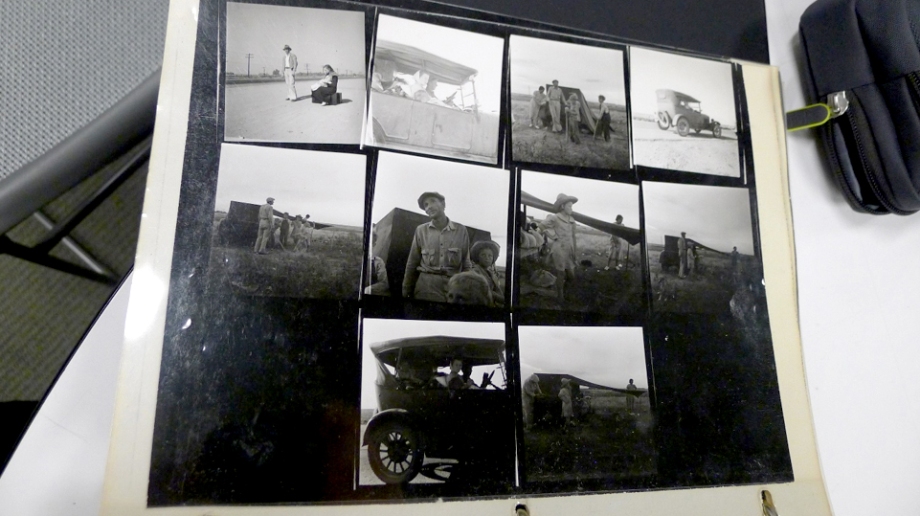
The size of the contact sheets reveals what type of camera she used: Some were large format, some were small format cameras.

A photocopy of a portrait of a family hitchhiking. Look at the woman. She is wearing sunglasses and her outfit is so beautiful and different from the other farm-wear. A gorgeous picture – timeless – and it shows Dorothea’s talented eye for composition too.
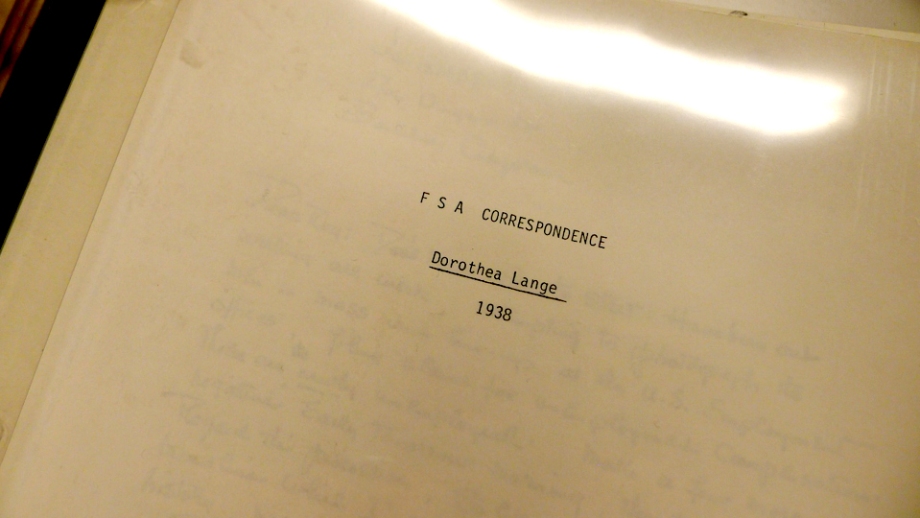
This album contained copies of correspondence between Dorothea Lange and (mostly) Roy E. Stryker, her employer at the FSA Photography Division, who hired her to take the photos in California. So interesting!
An unexpected bonus! In the downstairs exhibition area, an old migrant car was restored and packed with the stuff that Dust Bowl families would take with them. As you can see, kitchen gear and plates were also brought initially, even chairs and and tables, but often the people had to sell most of their stuff to survive.

And…. That’s the last photo! I hope you enjoyed this look behind the scenes. The trip took only around 10 days, but because of all the new input, it felt more like we spent weeks on the road! Next, I will mostly organize the photos, notes and audio that I gathered on the trip. I will start drawing as soon as possible – that’s the fun part!
Concept art from the book
I can’t resist posting some artwork that I made so far, to show you what the book will eventually look like. Here are some pictures that I’ve drawn as early concept art. They will probably not appear in the book, but they are made as a study.

Family on the road to California

A deep red Dust Bowl storm
 The main characters looking at the dust settling in the distance
The main characters looking at the dust settling in the distance
Below is a first draft page (which will probably not end up in the book):

Stay tuned for more! And thanks for reading till the end 🙂


 Concept art from the graphic novel
Concept art from the graphic novel

 Cars “drowned” in sand
Cars “drowned” in sand
 Eighteen-year-old mother from Oklahoma, now a California migrant, March 1937
Eighteen-year-old mother from Oklahoma, now a California migrant, March 1937


 Blowing Dust Area, a sign we saw on the road to California. I just had to take a picture!
Blowing Dust Area, a sign we saw on the road to California. I just had to take a picture! Jeffrey Briley and me in the Oklahoma History Center archives, with the many cameras!
Jeffrey Briley and me in the Oklahoma History Center archives, with the many cameras!









 An old shed, abandoned, but it perfectly captures the atmosphere that many of the old Dust Bowl photos have.
An old shed, abandoned, but it perfectly captures the atmosphere that many of the old Dust Bowl photos have. The old shed again, with dried out soil. Not as sandy as it would have looked in the thirties, but still it’s clear that the absence of rain is having its effect on the land.
The old shed again, with dried out soil. Not as sandy as it would have looked in the thirties, but still it’s clear that the absence of rain is having its effect on the land. Another abandoned Dust Bowl house. The houses would often stand next to a tree or a couple of trees. For shade? Or were they planted there by the inhabitants?
Another abandoned Dust Bowl house. The houses would often stand next to a tree or a couple of trees. For shade? Or were they planted there by the inhabitants? View of the road towards the panhandle, or ‘No Man’s Land’ as it used to be called. No wonder…
View of the road towards the panhandle, or ‘No Man’s Land’ as it used to be called. No wonder… Cattle in the field, not escaping this time!
Cattle in the field, not escaping this time!

 Here I’m taking a look at the colour of the soil. Yes, thorough research! It is important, because the colour of the dust clouds would change with the direction the sand was blowing from. If it came from the south, (for example) it would have been more red, from the north it was brown. By the colour of the clouds, the farmers could say about the storm: “There’s a visitor from Kansas today” or “We have a visitor from Oklahoma”.
Here I’m taking a look at the colour of the soil. Yes, thorough research! It is important, because the colour of the dust clouds would change with the direction the sand was blowing from. If it came from the south, (for example) it would have been more red, from the north it was brown. By the colour of the clouds, the farmers could say about the storm: “There’s a visitor from Kansas today” or “We have a visitor from Oklahoma”.





 We had a typical Oklahoma snack, which was also eaten during the thirties: Biscuits. They look like scones, but the texture is slightly different. The biscuits were featured in the Grapes of Wrath, as the Joads main meal on the road (served mostly with gravy). Although we weren’t expecting the biscuits to still be around at all, they turned up at every breakfast buffet in Oklahoma. They tasted delicious. And of course I had to take a photo for reference!
We had a typical Oklahoma snack, which was also eaten during the thirties: Biscuits. They look like scones, but the texture is slightly different. The biscuits were featured in the Grapes of Wrath, as the Joads main meal on the road (served mostly with gravy). Although we weren’t expecting the biscuits to still be around at all, they turned up at every breakfast buffet in Oklahoma. They tasted delicious. And of course I had to take a photo for reference!






 Cans from the thirties. It may seem like a detail, but it is very useful for my research.
Cans from the thirties. It may seem like a detail, but it is very useful for my research.

 Objects in the cupboards that reflect the time they lived in.
Objects in the cupboards that reflect the time they lived in.


 Checking out the interior!
Checking out the interior!







 Professor Dodd and his wife (left, and right), with me and professor Garcia in the middle.
Professor Dodd and his wife (left, and right), with me and professor Garcia in the middle.














 A very special newspaper: An original copy where Steinbeck’s essay “California’s Harvest Gypsies” was published in. He got a lot of space, and there was a huge photo too – and this was even before The Grapes of Wrath came out.
A very special newspaper: An original copy where Steinbeck’s essay “California’s Harvest Gypsies” was published in. He got a lot of space, and there was a huge photo too – and this was even before The Grapes of Wrath came out.
















 The main characters looking at the dust settling in the distance
The main characters looking at the dust settling in the distance